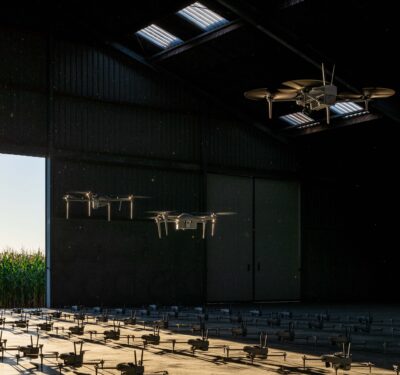Kicking off next week in Baltimore, for the 8th consecutive year, the Federal Aviation Administration (FAA) and the Association for Uncrewed Vehicle Systems International (AUVSI) will co-sponsor the 2024 FAA Drone & AAM Symposium. Previously two separate events – the FAA Drone Symposium and AAM Summit – this year’s event is the first staging to combine both technologies and audiences.

This year’s theme is “Connected Skies, Connected Communities,” and will focus on the importance of connectivity and integration in advanced aviation to benefit both urban and rural communities. Inside Unmanned Systems will be covering the event live.
Here is an in-depth preview from AUVSI on what attendees can look forward to next week.
Q: Can you provide an overview of the Connected Skies | Connected Communities Symposium and its main objectives?
A: The Connected Skies | Connected Communities Symposium aims to bring together a diverse group of stakeholders to advance collaboration and innovation in the drone and advanced air mobility (AAM) sectors. Our primary goal is to equip attendees with practical insights and updates from the Federal Aviation Administration (FAA) and industry leaders, focusing on the themes of connectivity and integration.
Q: What are the key learning outcomes you hope attendees will gain from this year’s symposium?
A: We hope attendees will understand the critical importance of connectivity and integration in advanced aviation, both in urban and rural settings. They will learn about the latest regulatory updates, technological advancements, and collaborative strategies necessary to drive progress in these areas. The symposium is designed to provide practical knowledge that can be applied directly to their work in the industry.
Q: The symposium emphasizes “Connected Skies. Connected Communities.” How will sessions delve into the importance of connectivity and integration?
A: When we talk about “Connected Skies. Connected Communities,” we’re focusing on advanced aviation’s role in connecting different communities via the skies. This involves integrating various technologies into the National Airspace System (NAS). Our sessions will cover the importance of collaboration between industry, regulators, and end-users to achieve a modernized, efficient airspace. We will explore how different stakeholders can work together to accelerate the integration of drones and AAM.
Q: Can you provide more details on the structure and content of the sessions?
A: Our sessions include keynotes from DOT leadership, panel discussions, workshops, and technical sprints. For example, on day one, we kick off with a plenary session focused on integrating drones and AAM into the NAS. We will also have sessions dedicated to public safety, emergency response, and beyond visual line of sight (BVLOS) operations. Each session aims to provide deep dives into specific areas, offering practical insights and actionable takeaways.
Q: How will the symposium address regulatory updates and technological advancements?
A: We anticipate significant discussions on BVLOS regulations, particularly with the Part 108 BVLOS rule and its timeline as mandated by the 2024 FAA Reauthorization Act. Additionally, we will cover the use of drones in public safety missions and how new regulations will expand their capabilities. The symposium will feature panels on regulatory compliance, the latest in detect and avoid (DAA) technologies, and how these advancements can be implemented to improve safety and efficiency.
Q: What insights will attendees gain about fostering collaboration and innovation among various stakeholders?
A: Attendees will learn about the critical role of collaboration in accelerating the integration of advanced aviation technologies. We will highlight successful partnerships between federal, state, and local governments, industry leaders, and technologists. The symposium will showcase how collaborative efforts can overcome challenges and unlock new opportunities in the drone and AAM sectors.
Q: How will the sessions on community impact educate attendees about the benefits and challenges of integrating advanced aviation technologies in different environments?
A: Our sessions will address how advanced aviation technologies can benefit both urban and rural communities by enhancing connectivity and integration. We will discuss the role of local and tribal governments in this process, focusing on how these entities can leverage new technologies to improve infrastructure and services. We aim to provide a comprehensive understanding of the community impact and practical strategies for successful integration.
Q: What networking opportunities will be available for attendees?
A: Networking is a key component of our symposium. We have built-in networking breaks throughout the program, offering attendees the chance to engage with FAA professionals, industry experts, and other participants. We also have a resource center where attendees can ask specific questions and get practical advice. Additionally, our new tech sprints will provide focused sessions on particular technologies, facilitating in-depth discussions and networking.
Q: What future trends and developments in the drone and AAM industries will be discussed?
A: We will cover future trends such as the continued development of BVLOS operations, advancements in DAA technologies, and the integration of drones into public safety and emergency response frameworks. Attendees will gain insights into how these trends will shape the future of aviation and what they can do to stay ahead of the curve.
Q: What practical takeaways can attendees expect from the symposium?
A: Attendees can expect to gain a thorough understanding of the current regulatory landscape, practical knowledge on integrating advanced aviation technologies, and insights into successful collaboration strategies. The tech sprints will provide deep dives into specific solutions, offering practical guidance on implementing these technologies in their own operations.
Q: Is there anything else you’d like to add for our readers?
A: This symposium is an excellent opportunity for anyone interested in understanding more about policy, regulations, and the technical aspects of advanced aviation. Whether you’re an industry veteran or new to the field, there will be valuable content for everyone. We encourage everyone to attend, engage, and take advantage of the networking opportunities to connect with leaders and innovators in the industry.






